 |
||
|
||
| ||
160 GB 2.5" Perpendicular Magnetic Recording hard drives
|
Series |
Hitachi Travelstar 5K160 |
Samsung SpinPoint M80 |
Seagate Momentus 5400.3 |
WD Scorpio ML80 |
| Models |
HTS541616J9AT00
HTS541616J9SA00 and others. |
HM160JP¡(JI)
HM120IP¡(II) HM080HP¡(HI) |
ST9160821A
ST9160822AS and others. |
WD1600BEVS
WD1600BEAS and others. |
| Capacity, GB |
160
120 80 60 40 |
160
120 80 |
160
120 100 80 60 40 |
160
120 100 80 60 40 |
| Number of heads/platters |
4/2
3/2 2/1 1/1 |
4/2
3/2 2/1 |
4/2
3/2 2/1 1/1 |
4/2
3/2 2/1 |
| Buffer, MB |
8
|
8
|
8
|
8 or 2
|
| Average seek time, ms, reading/writing |
11/13
|
12/14
|
12,5/-
|
12/-
|
| Maximum buffer to disk data transfer rate, Mbits/s |
540 (466)
|
530
|
44 MB/s
|
600
|
| Interface |
SATA/150 and UltraATA/100
|
SATA/150 and UltraATA/100
|
SATA/150 and UltraATA/100
|
SATA/150
|
| Operating shock resistance (2ms), G |
325
|
325
|
350
|
300
|
| Non-operating shock resistance (1ms), G |
1000
|
1000
|
900
|
900
|
| Idle acoustic noise, dBA, type. |
22 (25 max.)
|
24 (2 platters)
22 (1 platter) |
23
|
22
|
| Seek acoustic noise, dBA, type. |
24 (27 max.)
|
26 (2 platters)
25 (1 platter) |
29
|
25
|
| Temperature, P¡, on(off) |
+5b¦55
(-40b¦+65) |
+5b¦55
(-40b¦+70) |
+0b¦60
(-40b¦+70) |
+0b¦60
(-40b¦+65) |
| Power consumption, Watt: spin-up seek/read-write idle/standby |
5.0 1.8 0,8/0,25 |
4.5 2,1/2,0 0,6/0,25 |
5.0 2,0/2,0-1,8 0,8/0,2 |
5.0 2.5 1,3(2,0)/0,25 |
We shall skip the analysis of their specifications (you can do it yourself with our table) and their technologies (for example, a head parking technology that guarantees 600 000 Load/Unload cycles), and proceed straight to our tests.
All our contenders have an 8 MB buffer. SATA models support NCQ, but we don't use NCQ in these tests and suggest that our readers get the details on the web site. The 7k1 drives are represented by UATA models, and PMR 5k4 drives (six models) are represented by models with both interfaces. However, WD and Hitachi, for example, try to supply as few PATA models as possible, replacing them with SATA modifications.
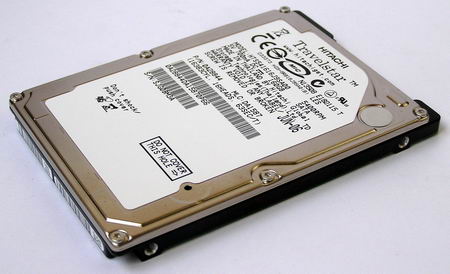
Hitachi Travelstar 5K160 HTS541616J9SA00

Hitachi Travelstar 7K100 HTS721010G9AT00
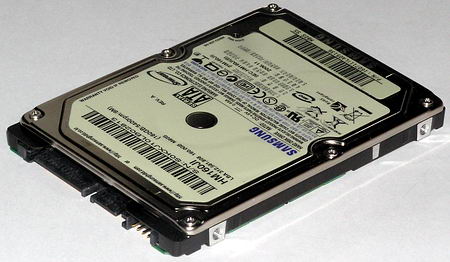
Samsung SpinPoint M80 HM160JI

Samsung SpinPoint M80 HM160JC
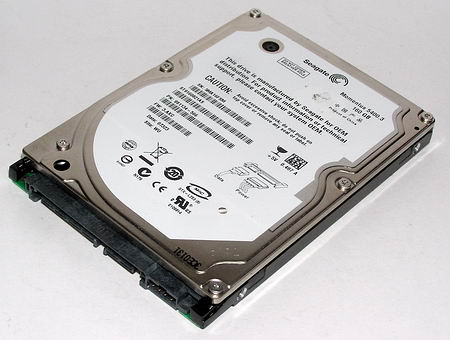
Seagate Momentus 5400.3 ST9160821AS
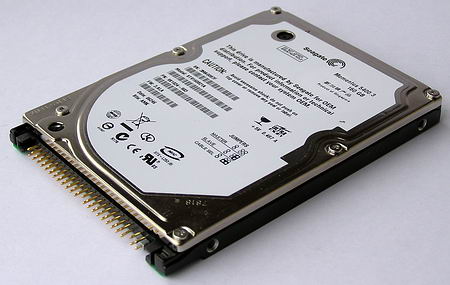
Seagate Momentus 5400.3 ST9160821A
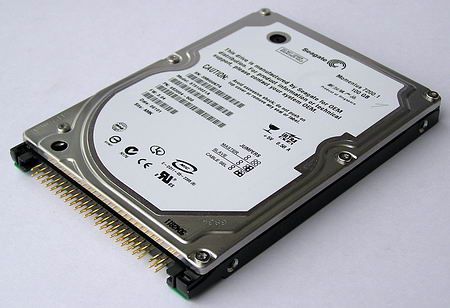
Seagate Momentus 7200.1 ST910021A
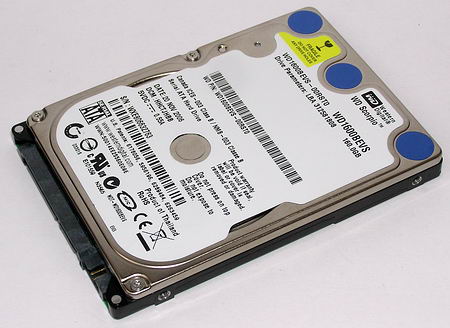
WD Scorpio ML80 WD1600BEVS
Our HDD benchmark procedure has suffered no changes so far. So you can compare results of the new drives with models already reviewed on our web site. We used the following testbed:
The mobile drives are mounted firmly on the metal racks of a testbed chassis and connected to the UltraATA/100 or SerialATA ports on the ICH5 bridge. No special cooling devices for the hard drives were used.
Graphs of linear transfer rates are published below.
|
WD Scorpio ML80 WD1600BEVS
|
Hitachi Travelstar 5K160 HTS541616J9SA00
|
|
Samsung SpinPoint M80 HM160JI
|
Samsung SpinPoint M80 HM160JC
|
|
Seagate Momentus 5400.3 ST9160821AS
|
Seagate Momentus 5400.3 ST9160821A
|
Note the slightly different approaches of manufacturers to data density, which is increased owing to PMR: some of them (Seagate, Samsung) condense tracks along the platter radius (especially at the initial stage); others (Hitachi, WD) increase linear data density along the tracks, which resulted in higher growth of linear transfer rates than in competing products. Leadership of 5k4 PMR models from WD and Hitachi is the best proof (see the diagram).
But Seagate Momentus 5400.3 drives manufactured with a one-year difference also demonstrate noticeable gains in linear transfer rates relative to each other. So adaptive formatting with streamlined PMR technologies can improve performance of storage drives within the same model/series. We should also mention that 160 GB 5k4 models have practically caught up with 7k1 models of the previous generation in linear access rates. Only Hitachi 7K100 has a little advantage here.
The average random access time for reading differs in our contenders:
Samsung hard drives are the slowest here, although WD models are not much faster. The Hitachi drive demonstrates a tad better results. But only Seagate Momentus 5400.3 drives show outstanding results in this task, they almost catch up with 7k1 models, which latency is lower by 1.5 ms! We can only congratulate Seagate M5400.3 with its results in this test - it even catches up with the M7200.1 models. But it must be noted that these drives have the noisiest active seek mode. You can actually hear it, unlike the situation with competing drives. Seek acoustics management is supported by all manufacturers, except for Seagate.
Efficiency of caching data for writing can be evaluated with the random access test under Windows.
Seagate models are outperformed here. WD and Hitachi drives are again better than other models. So we can expect the best results from them in consumer applications.
However, PMR models from Samsung offer the best performance in multi-threaded writing and reading tests with 100 MB files - they do it owing to good optimizations of caching algorithms.
Seagate drives demonstrate the slowest multi-threaded reading. What concerns writing, it's Hitachi. Priority of firmware algorithms in this test (even though it's a streaming test) makes 7k1 models slower (!) than the fastest 5k4 models. It must be taken into account, when you choose a hard drive for compact systems.
We evaluate HDD performance in a typical PC user mode with WinBench 99 Disk WinMark in Business and High-End patterns (open the links to the diagrams), as well as with two other popular track tests - Futuremark PCmark04 and C'T H2benchW.
All out contenders come in a tight group in the first test. We have leaders, of course (Hitachi 7k1 and Samsung/WD PMR 5k4 models), but they are not unconditional favourites.
The situation in C'T H2benchW is different. Hitachi Travelstar 7K100 is the absolute leader here. But the second place is unexpectedly taken by Seagate M5400.3 SATA, it even outperforms the M7200.1 model from the same manufacturer! However, many other 160 GB 5k4 models fare well in this test, especially hard drives from Samsung and Hitachi.
And finally, the Adobe Photoshop swapping performance test again shows booming competition of the new 5k4 models with last-year 7k1 ones: WD Scorpio ML80 is the obvious leader among its "fellow-tribesmen". It has almost caught up with the excellent Hitachi 7K100, and Samsung models have caught up with Seagate 7K100.
And now let's see how our models under review fare in various IOmeter patterns, although they are not typical patterns for these drives. However, using databases on notebooks is not an exotic situation, so these patterns have a practical aspect as well. Let's start with mean results of traditional File Server, Web Server and Database patterns.
As we can see, low seek time does not necessarily contribute to a victory in this test - although the 7k1 models are leading here (if we don't take into account results of SATA 5k4 drives with NCQ based on the SiI3124 controller). The fastest 5k4 models are at the back of the pack (the WD model with its high seek time is among them). We again repeat that firmware algorithms are as important as physical aspects of hard drives.
In more personal tasks, such as reading, writing, and copying large and small files, performance is evaluated with our own IOmeter patterns with random access to data from the entire disc (the diagram contains averaged results).
We can finally see almost absolute leadership of the 7k1 models. It happens mostly owing to high results in the large file copy test. But Hitachi 5k4 is getting close to Seagate 7k1. And Samsung models are generally fast here. The "updated" Seagate M5400.3 performs almost on a par with the leaders now. By the way, the WD model writes files very fast, and slumps in copying files.
You can have a look at the detailed results of each test at the following links:
No less interesting results are demonstrated in the streaming read/write test with large or small blocks. This test imitates a digital VCR in timeshifting mode or video editing HDD load. Both Hitachi drives (7K100 and 5K160) perform well with large blocks. What concerns small blocks, 5k4 models from Samsung and Hitachi lead here. They again prove that physical parameters of 2.5-inch hard drives are not as important for high performance in applications as optimal firmware algorithms of caching data.
Power consumption and heat dissipation of mobile hard drives is no less important than their performance. We measured typical power consumption of hard drives in various modes, see Table 2.
Table 2. Current drain (mA) of hard drives on the +5V line in various modes.
|
Model / Mode |
Idle |
ATA transfer |
Write |
Read |
Seek |
Start |
Label |
| Fujitsu MHV2120BH |
140
|
380
|
460
|
440
|
480
|
710
|
600
|
| Hitachi TS 7K100 HTS721010G9AT00 |
120
|
370
|
570
|
690
|
580
|
830
|
1100
|
| Hitachi TS 7K100 HTS721010G9SA00 |
280
|
540
|
750
|
850
|
740
|
850
|
1100
|
| Hitachi TS 5K160 HTS541616J9SA00 |
170
|
370
|
530
|
460
|
500
|
810
|
700
|
| Hitachi TS 7K60 HTS726060M9AT00 |
150
|
370
|
650
|
850
|
650
|
830
|
1100
|
| Samsung SpinPoint M80 HM160JI |
155
|
380
|
530
|
490
|
460
|
630
|
850
|
| Samsung SpinPoint M80 HM160JP¡ |
100
|
350
|
530
|
480
|
440
|
610
|
850
|
| Seagate Momentus 7200.1 ST910021A |
190
|
430
|
630
|
690
|
570
|
720
|
580
|
| Seagate Momentus 5400.3 ST9160821AS |
170
|
520
|
630
|
630
|
530
|
670
|
487
|
| Seagate Momentus 5400.3 ST9160821A |
130
|
310
|
510
|
560
|
460
|
580
|
487
|
| WD Scorpio ML80 WD1600BEVS |
175
|
410
|
670
|
650
|
550
|
800
|
550
|
We can see that power consumption of SATA hard drives is generally higher by 0.2-0.3 W in the typical notebook usage mode and higher by 0.5 W in the intensive usage mode. The 7k1 models consume much more power than the 5k4 models of the latest generation so far, their performance being generally on a par! The most economical 160 GB models are UATA drives from Samsung and Seagate. Hitachi SATA model is also economical under heavy load. WD Scorpio drives turned out disappointingly hot, just like the 7k1 SATA models (see the details in the corresponding reviews).
Advance of the first generation of mobile PMR drives with the spindle rotational speed of 5400 rpm and top capacity of 160 GB did not make a revolution - many people were looking forward to it, hoping for the new recording method. But it stirred up some foundations. It's not that easy to choose a high-performance mobile hard drive now, because mobile 7k1 models are not the only leaders. They are sometimes outscored by 160 GB 5k4 models not only in capacity and power efficiency, but also in performance in some applications. However, hard drives are progressing. Hitachi and Seagate will launch the first generation of promising PMR 7k1 models soon. Besides, competitors are also flexing muscles with their 250 GB 5k4 models...
Write a comment below. No registration needed!
|
Article navigation: |
| blog comments powered by Disqus |
| Most Popular Reviews | More RSS |
 |
Comparing old, cheap solutions from AMD with new, budget offerings from Intel.
February 1, 2013 · Processor Roundups |
 |
Inno3D GeForce GTX 670 iChill, Inno3D GeForce GTX 660 Ti Graphics Cards A couple of mid-range adapters with original cooling systems.
January 30, 2013 · Video cards: NVIDIA GPUs |
 |
Creative Sound Blaster X-Fi Surround 5.1 An external X-Fi solution in tests.
September 9, 2008 · Sound Cards |
 |
The first worthwhile Piledriver CPU.
September 11, 2012 · Processors: AMD |
 |
Consumed Power, Energy Consumption: Ivy Bridge vs. Sandy Bridge Trying out the new method.
September 18, 2012 · Processors: Intel |
| Latest Reviews | More RSS |
 |
Retested all graphics cards with the new drivers.
Oct 18, 2013 · 3Digests
|
 |
Added new benchmarks: BioShock Infinite and Metro: Last Light.
Sep 06, 2013 · 3Digests
|
 |
Added the test results of NVIDIA GeForce GTX 760 and AMD Radeon HD 7730.
Aug 05, 2013 · 3Digests
|
 |
Gainward GeForce GTX 650 Ti BOOST 2GB Golden Sample Graphics Card An excellent hybrid of GeForce GTX 650 Ti and GeForce GTX 660.
Jun 24, 2013 · Video cards: NVIDIA GPUs
|
 |
Added the test results of NVIDIA GeForce GTX 770/780.
Jun 03, 2013 · 3Digests
|
| Latest News | More RSS |
Platform · Video · Multimedia · Mobile · Other || About us & Privacy policy · Twitter · Facebook
Copyright © Byrds Research & Publishing, Ltd., 1997–2011. All rights reserved.